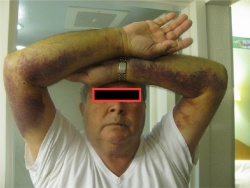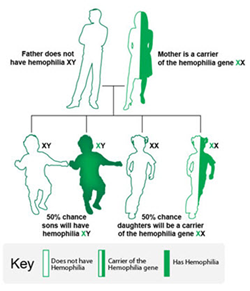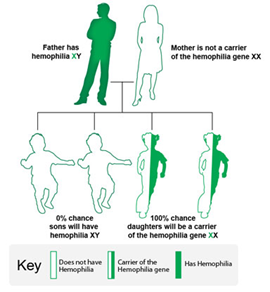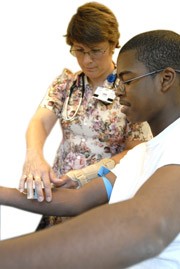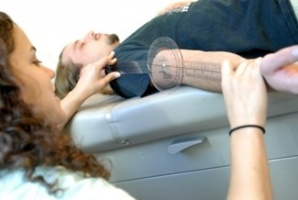Haemophilia
Original Editors - Alyssa Elliott, Chelsea Reinhart
Top Contributors - Chelsea Reinhart, Alyssa Elliott, Tarina van der Stockt, Kim Jackson, Mandy Roscher, Robin Tacchetti, Elaine Lonnemann, Tony Lowe, WikiSysop, Lucinda hampton, Jess Bell, Aminat Abolade and Stacy Schiurring
Definition/Description[edit | edit source]
Hemophilia is a congenital X-linked bleeding disorder in which blood does not properly clot. It is categorized as a disorder of hemostasis. Hemostasis, the stopping of bleeding after a blood vessel is injured, normally is divided into two separate processes—primary and secondary hemostasis. In hemophilia, secondary hemostasis (which essentially results in the formation of a fibrin clot) is defected. Thus, deficient clotting is due to an abnormality of the functional plasma-clotting proteins, factors VIII and IX, that are involved in this process. [1]
There are two primary types of this disease—hemophilia A and hemophilia B. Hemophilia A (or classic hemophilia) affects approximately 80% of all cases. Hemophilia B (or Christmas disease) constitutes for approximately 15% of all cases. The difference between the two types is which clotting factor is deficient. [2]
Injuries and surgeries can cause bleeding episodes in individuals with hemophilia. Most also experience episodes of spontaneous bleeding. In regards to bleeding, they do not bleed any faster than the average person, but they do bleed for a longer period of time.
Severity of the disease is determined by blood tests. These tests determine the percentage of clotting factor present in blood plasma; concentrations from 50%-150% is normal. The severity of hemophilia can be described as mild, moderate, and severe.
-Mild hemophilia:
-25% of cases
-Spontaneous hemorrhages are rare
-Deep muscle and joint bleeding are uncommon
-Injury, trauma, surgery, and dental injury trigger bleeding
-these symptoms are addressed the same as with individuals with severe hemophilia
-Moderate hemophilia:
-15% of cases
-Spontaneous hemorrhages are usually not an issue
-Minor trauma can result in major bleeding incidences
-Severe hemophilia:
-60% of cases
-Spontaneous bleeding
-Slight trauma may precipitate bleeding into deep muscle and joints[2]
The Diagnostic section on this page includes a table displaying severity and the levels of factor VIII or IX for each in the blood.
Prevalence[edit | edit source]
Hemophilia, the most common inherited blood clotting disorder associated with clotting factor deficiencies, affects 1 in 5,000 male births. It is estimated that approximately 20,000 males in the United States, and approximately 400,000 people in the world have hemophilia. All racial and ethnic groups are affected by this disease. [2][3][4]
Characteristics/Clinical Presentation[edit | edit source]
Hemophilia A and hemophilia B both present in similar ways. Bleeding occurrences can first be noted in infants when being circumcised or when receiving heel sticks, immunizations, or blood draws. Other features to be noted include the formation of hematomas (or bruising). Hematomas can present in infants or children from receiving injections or while being held (such as from being lifted by the elbows or from under the armpits). Hematomas can result from excessive bruising due to minor trauma, delayed hemorrhage after minor injury, persistent bleeding after losing a tooth, or bleeding into joints and muscles.[2]
Clinical signs and symptoms of hemophilia can present in several different ways. The most common presentation of hemophilia is hemarthrosis, in which bleeding occurs inside joint spaces. The occurrence of joint bleeds increases as a baby begins to walk; these episodes can vary in severity, from swelling with mild pain to extremely swollen with severe pain. The joint most commonly affected is the knee “followed by the ankle, elbow, hip, shoulder, and wrist[2].”[1]
Acute hemarthrosis symptoms include:
• swelling
• pain
• heat around joint
• tenderness
• decreased motion
• tingling, aura, or prickling sensation
• stiffening into the position that is comfortable (usually flexion)[1]
These signs and symptoms are very important for individuals with hemophilia to be aware of. When they present, steps should be taken to address the episode of acute bleeding.
If there are recurrent episodes of hemarthrosis, hemophiliac joint disease may develop. This disease can lead to further symptoms such as:
• progressive decreased motion
• flexion contractures
• muscle atrophy[1]
The second most common presentation of hemophilia is muscle hemorrhage, where bleeding occurs into muscles. A muscle hemorrhage can be massive and more insidious. They commonly occur in muscles that flex such as the gastrocnemius, iliopsoas, and the forearm flexor surface. The symptoms presenting with muscle hemorrhage can include:
• gradually intensifying pain
• loss of sensation
• decreased motion at surrounding joints
• muscle assuming comfortable position (usually shortened)
• protective muscle spasms[1]
Hemophilia and Women
Women with hemophilia often experience painful, heavy, long-lasting periods. They may also experience oozing after ovulation from their ovary. Females who are carriers of the hemophilia gene may also experience abnormal bleeding when their clotting factor is low and can lead to coagulation problems. Abnormal bleeding can occur from minor trauma, nosebleeds, bruising, dental extractions, and complications of pregnancy. These instances are often overlooked since hemophilia is less common in women.[2]
Associated Co-morbidities[edit | edit source]
• HIV (more common prior to 1986 because purification techniques were not in place)
• AIDs
• Hepatitis A
• Hepatitis B
• Hepatitis C[2]
• Osteoporosis[5]
Individuals with hemophilia are also at a higher risk for developing hypertension, heart disease, kidney disease, obesity, and sexual dysfunction compared to the general population.[5]
Medications[edit | edit source]
Individuals with hemophilia may take pain medications “to control pain in acute bleeding and chronic arthropathies” (joint diseases)[2]. Common pain medications, including acetylsalicylic acid (ASA) and nonsteroidal anti-inflammatory drugs (NSAIDs), for instance ibuprofen and aspirin, cannot be used due to their platelet inhibiting function. In addition, any medication with derivatives of aspirin must be used cautiously (i.e. corticosteroids which may be used for chronic synovitis). Certain COX-2 inhibitors as well as acetaminophen are safe pain medication alternatives.[3]
Diagnostic Tests/Lab Tests/Lab Values[edit | edit source]
In order to diagnose hemophilia, screening tests will be performed, as well as clotting factor tests (also called factor assays). The blood tests reveal the type and severity of hemophilia. If there is a family history of hemophilia, a mother can also request to have a blood test performed from the baby boy’s umbilical cord immediately after birth.[6]
Screening Tests:
Complete Blood Count (CBC)
- This test measures the number and size of red blood cells, the amount of hemoglobin, and the platelet number in the blood. This value is normal for people with hemophilia, but the red blood cell and hemoglobin counts can be low with bleeding for an extended period of time or when individuals have unusually heavy episodes of bleeding.[6]
Activated Partial Thromboplastin Time (APTT) Test
- This test measures the time it takes for blood to clot while measuring the “clotting ability of factors VIII (8), IX (9), XI (11), and XII (12)[6].” A person with hemophilia would display an increased blood clotting time in their results.
Prothrombin Time (PT) Test
- This test measures how long it takes for the blood to clot while primarily measuring the “clotting ability of factors I (1), II (2), V (5), VII (7), and X (10)[6].” Results will typically be normal for individuals with hemophilia.
Fibrinogen Test
- This test allows physicians to assess their patient’s ability to form blood clots. This test is usually performed if a patient has abnormal APTT and/or PT test results, and may also be performed along with other clotting tests.[6]
Clotting Factor Tests:
• These are required for a bleeding disorder to be diagnosed. This blood test reveals the type and severity of hemophilia.[6]
| Severity of Hemophilia |
Factor VIII or IX Levels in the Blood |
|---|---|
| Mild |
>5% but <50% |
|
Moderate |
1% - 5% |
|
Severe |
<1% |
Modified From: Centers for Disease Control and Prevention [Internet]. Diagnosis; 13 September 2011 [cited 8 April 2016]. Available from: http://www.cdc.gov/ncbddd/hemophilia/diagnosis.html
Etiology/Causes[edit | edit source]
Blood clotting factors VIII and IX are found on the X chromosome making this an X-linked disorder, and thus making hemophilia rare in females. Since females carry two X-chromosomes, they only develop hemophilia when both chromosomes are affected. Males will always develop hemophilia when they carry an affected X-chromosome (since they only have one). Two-thirds of hemophilia cases have an evident familial history, however, one-third of cases result from spontaneous genetic mutation.[2][3]
Systemic Involvement[edit | edit source]
A person with hemophilia may develop issues with their central nervous system (CNS). Two issues that can develop are:
• Intraspinal hemorrhage (rare)
• Intracranial hemorrhage (sign & symptoms of this include)
o Irritability, lethargy
o Feeding difficulties (children)
o Seizures
o Unequal pupils
o Vomiting
o Apnea
o Tense, bulging fontanelles (children)
o Paralysis
o Death [1]
A person with hemophilia may develop gastrointestinal (GI) system issues. Signs and symptoms of GI involvement include:
• Fever
• Abdominal distention and pain
• Melena (bloody stool)
• Hip flexion contracture (iliopsoas muscle spasm due to retroperitoneal hemorrhage)
• Hematemesis (vomiting blood)
• Low groin/abdominal pain (secondary to bleeding into large intestine wall or iliopsoas muscle)[1]
A person with hemophilia may develop inhibitors. The development of inhibitors is a serious complication. When this occurs, the “inhibitors (also called antibodies) form in the blood to fight against the foreign factor proteins. This stops the factor concentrates from being able to fix the bleeding problem[7].”
Possible concerns:
• increased difficulty controlling bleeding
• Increased cost of care/treatments
• Often experience more joint disease from bleeding
• Reduced quality of life[4]
• Reduced participation in exercise/physical activity
• Should be monitored carefully during all activity
• Should be treated with rest and ice for any adverse reactions
• Should avoid high-risk sports[8]
Medical Management (current best evidence)[edit | edit source]
At this time, there is no known cure or prenatal treatment for hemophilia. The goal for current treatment is to stop and prevent bleeding. There are specialized comprehensive hemophilia treatment centers (HTC) to address all related issues of the disorder. HTCs provide patients with a team of “physicians (hematologists or blood specialists), nurses, social workers, physical therapists and other health care providers, who are specialized in the care of people with bleeding disorders[9]”. HTCs have been proven to reduce the rates of disability, morbidity, and mortality[2].
Factor replacement therapy via infusion utilizes clotting factor concentrates that aid in proper blood clotting; this is the best way to treat hemophilia. Individuals can learn how to perform infusions themselves to stop bleeding episodes (as soon as they occur) as well as prevent most bleeding episodes by performing infusions regularly.[2][9]
Tips for Maintaining Health with Hemophilia
“The National Hemophilia Foundation (NHF), along with the Centers for Disease Control and Prevention (CDC), developed Do the 5! This education project is part of the National Prevention Program to help prevent or reduce the complications of bleeding disorders[10].”
5 Tips for Healthy Living (from the National Hemophilia Foundation’s National Prevention Program)
- Get an annual comprehensive checkup at a hemophilia treatment center
- Get vaccinated--Hepatitis A and B are preventable
- Treat bleeds early and adequately
- Exercise and maintain a healthy weight to protect your joints
- Get tested regularly for blood-borne infections[4]
Physical Therapy Management (current best evidence)[edit | edit source]
Preferred Practice Patterns
4B: Impaired Posture (joint deformity)
4D: Impaired Joint Mobility, Motor Function, Muscle Performance, and Range of Motion Associated with Connective Tissue Dysfunction
5A: Primary Prevention/Risk Reduction for Loss of Balance and Falling
5C: Impaired Motor Function and Sensory Integrity Associated with Nonprogressive Disorders of the Central Nervous System: Congenital Origin or Acquired in Infancy or Childhood (CNS involvement)
5F: Impaired Peripheral Nerve Integrity and Muscle Performance Associated with Peripheral Nerve Injury (nerve compression)
6F: Impaired Ventilation and Respiratory/Gas Exchange Associated with Respiratory Failure (coagulation defect)[2]
Treatment Overview
Physical therapy (PT), through the use of muscular strengthening, neuromuscular re-education, gait training, and patient education, is effective in decreasing the number of bleeding episodes. It is used to prevent additional deformations (maintain joint positioning) as well as control pain and supplementary bleeding during acute hemorrhages. In regards to exercise, therapists can “help individuals with hemophilia identify, seek out, and enjoy physical activity, exercise, and sport participation that provide benefits that outweigh the risks[2].” Fortunately, overall, medical treatment today is more aggressive in nature so less damage to joints occur. Thus, much of the focus of PT has shifted to preventative rather than rehabilitation.
Importance of Exercise
Exercise and physical activity is imperative for this population because joint immobilization (not moving your joints) can progress to muscle diminishing, joint instability and recurrent bleeding, and the early development of arthropathy. Aquatic therapy is a great modality for individuals with hemophilia and is especially beneficial for those with chronic arthropathy due to the decreased compressive forces across joints the water vs. land provides.[2]
Strength Training
Strength training in individuals with hemophilia increases muscular strength, improves circulation and joint stability, and may reduce the risk of spontaneous bleeding.
What the physical therapist should know:
• Warming-up before the intervention and a cooling-down afterward are very important
• Perform all strength training exercises within pain-free ROM
• Patients should never attempt maximal lifts[2]
Therapy and Hemarthrosis
Therapists should be aware and alert for early signs of bleeding episodes. Early bleeding signs are listed under acute hemarthrosis clinical signs and symptoms mentioned in the Characteristics/Clinical Presentation section above.
During the acute episode of hemarthrosis, range of motion (ROM) should be measured within the pain-free range and strength tests should not be taken.
Wraps, slings, splints, or assistive devices may be indicated. Since synovitis or articular contracture is an underlying condition of hemophilia, muscle shortening may occur. Dynamic or static night splints are useful in this case to provide a low-load stretch.[2]
| Joint and Muscle Bleed Management | ||
|---|---|---|
| Joint: Acute Stage |
Joint: Subacute Stage |
Muscle |
| Factor replacement |
Factor replacement (if indicated) |
Factor replacement |
| Red, Ice, Compression (at least 10-15 minutes to area), Elevation (RICE) |
Progressive AROM exercises |
RICE |
| Pain-free ROM |
Wean slings and splints |
Appropriate WB status (bed rest indicated for iliopsoas bleed) |
| Pain medication |
Progressive weight bearing |
Progressive movement |
Modified from Peterson C, Goodman CC, The Hematologic System. In: Goodman CC, Fuller KS editors. Pathology: Implications for the Physical Therapist. 3rd ed. St. Louis: Elsevier Inc, 2009. P726.
Joint range of motion (ROM) limitations can occur post muscle shortening from repeated bleeds in the same body area. Splinting or serial casting may be indicated for these individuals.
Leg length discrepancy, a long-term result of joint arthropathy, must be monitored and managed to prevent further impairments (such as low back pain).[2]
Differential Diagnosis[edit | edit source]
It is important to ensure hemophilia is properly diagnosed. Below are other medical issues or impairments that may present similarly and if not diagnosed appropriately could lead to a variety of medical issues.
- Nerve impingement: A person with hemophilia may experience bleeding into the iliacus muscle or the psoas. Bleeding in these areas can apply pressure to the femoral nerve branch that supplies the skin of the anterior thigh and a person may have loss of sensation.
- Appendicitis: A person with hemophilia may have symptoms that mimic appendicitis when they have muscle bleeding on the right side in their lower abdomen.[1]
- Disseminated Intravascular Coagulation (DIC)[11]
- Von Willebrand Disease (VWD)[12]
- Thrombocytopenia[13]
Case Reports/ Case Studies[edit | edit source]
1. Girardi D da M, Silva DRA, Villaça PR, Souza CE, Fonseca LG, Bastos DA, Hoffa PMG. Acquired hemophilia A in a patient with advanced prostate cancer. Journal of Autopsy & Case Reports. 2015;5(2):55-59.
http://www.ncbi.nlm.nih.gov/pmc/articles/PMC4584669/
2. Iioka F, Shimomura D, Nakamura F, Ohno H, Yada K, Nogami K, Shima M. Long-term treatment course of a patient with mild haemophilia A who developed a high titre factor VIII inhibitor. Journal of Haemophilia. 2014;20(6):e402-e404.
http://www.ncbi.nlm.nih.gov/pmc/articles/PMC4232888/
3. Janbain M, Leissinger CA, Kruse-Jarres R. Acquired hemophilia A: emerging treatment options. Journal of blood medicine. 2015;6:143-150.
http://www.ncbi.nlm.nih.gov/pmc/articles/PMC4431493/
Resources
[edit | edit source]
• National Hemophilia Foundation: https://www.hemophilia.org/
• Genetics Home Reference page for hemophilia: https://ghr.nlm.nih.gov/condition/hemophilia
• CDC page for hemophilia: http://www.cdc.gov/ncbddd/hemophilia/
• Information for people with Hemophilia: http://www.cdc.gov/ncbddd/hemophilia/people.html
• Hemophilia Federation of America: http://www.hemophiliafed.org/
• Merck Manual Professional Version: Hemophilia: http://www.merckmanuals.com/professional/hematology-and-oncology/coagulation-disorders/hemophilia
• Merck Manual Consumer Version: Hemophilia: http://www.merckmanuals.com/home/blood-disorders/bleeding-due-to-clotting-disorders/hemophilia
• Steps for Living - Hemophilia: https://stepsforliving.hemophilia.org/basics-of-bleeding-disorders
References[edit | edit source]
see adding references tutorial.
- ↑ 1.0 1.1 1.2 1.3 1.4 1.5 1.6 1.7 Goodman CC, Snyder TEK. Differential Diagnosis for Physical Therapists: Screening for Referral. 5th ed. St. Louis: Elsevier Inc, 2013.
- ↑ 2.00 2.01 2.02 2.03 2.04 2.05 2.06 2.07 2.08 2.09 2.10 2.11 2.12 2.13 2.14 2.15 2.16 Peterson C, Goodman CC, The Hematologic System. In: Goodman CC, Fuller KS editors. Pathology: Implications for the Physical Therapist. 3rd ed. St. Louis: Elsevier Inc, 2009. P678-741.
- ↑ 3.0 3.1 3.2 Srivastava A, Brewer AK, Mauser‐Bunschoten EP, Key NS, Kitchen S, Llinas A, Ludlam CA, Mahlangu JN, Mulder K, Poon MC, Street A. Guidelines for the management of hemophilia. Haemophilia. 2013 Jan 1;19(1):e1-47. http://onlinelibrary.wiley.com/doi/10.1111/j.1365-2516.2012.02909.x/full (accessed 03 April 2016).
- ↑ 4.0 4.1 4.2 Centers for Disease Control and Prevention. Hemophilia Facts. http://www.cdc.gov/ncbddd/hemophilia/facts.html (accessed 8 April 2016).
- ↑ 5.0 5.1 Living With Hemophilia. Aging with hemophilia. http://www.livingwithhemophilia.ca/adults-teens/aging.php (accessed 3 April 2016).
- ↑ 6.0 6.1 6.2 6.3 6.4 6.5 Centers for Disease Control and Prevention. Hemophilia Diagnosis. http://www.cdc.gov/ncbddd/hemophilia/diagnosis.html (accessed 3 April 2016).
- ↑ World Federation of Hemophilia. What are inhibitors?. http://www.wfh.org/en/page.aspx?pid=637#Inhibitors (accessed 3 April 2016).
- ↑ Negrier C, Seuser A, Forsyth A, Lobet S, Llinas A, Rosas M, Heijnen L. The benefits of exercise for patients with haemophilia and recommendations for safe and effective physical activity. Haemophilia. 2013 Jul 1;19(4):487-98. http://onlinelibrary.wiley.com/doi/10.1111/hae.12118/full (accessed 08 April 2016).
- ↑ 9.0 9.1 Centers for Disease Control and Prevention. Hemophilia Treatment. http://www.cdc.gov/ncbddd/hemophilia/treatment.html (accessed 8 April 2016).
- ↑ Steps For Living. Maintaining a Healthy Body. https://stepsforliving.hemophilia.org/step-out/maintaining-a-healthy-body/do-the-5 (accessed 10 April 2016).
- ↑ MedlinePlus. Disseminated intravascular coagulation (DIC). https://www.nlm.nih.gov/medlineplus/ency/article/000573.htm (accessed 8 April 2016).
- ↑ Centers for Disease Control and Prevention. Facts About von Willebrand Disease. http://www.cdc.gov/ncbddd/vwd/facts.html (accessed 8 April 2016).
- ↑ National Heart, Lung, and Blood Institute. What Is Thrombocytopenia?. http://www.nhlbi.nih.gov/health/health-topics/topics/thcp/ (accessed 8 April 2016).

